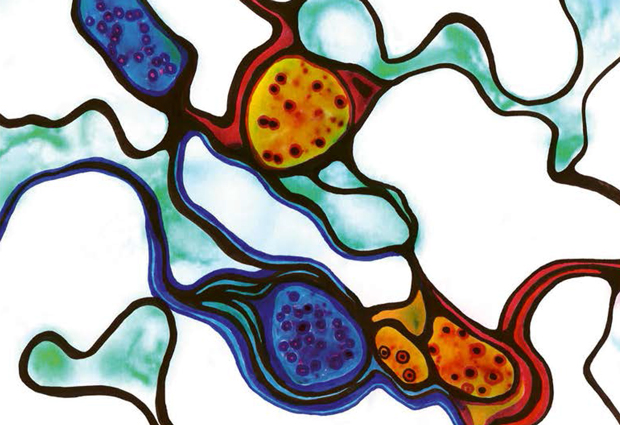
Read the latest Issue
They are soldiers on patrol, on the lookout for invaders. But first of all, they must learn who not to kill.

The T-cells that help to track down and eliminate disease-causing microbes inside our body have to be able to distinguish between invaders and our own cells. The importance of this ability becomes clear in people suffering from auto-immune diseases, in which the immune system attacks the body’s own cells.
As they mature, T-cells travel from the bone marrow to the thymus, where they are trained not to react to markers called self-antigens, which brain, muscle, and all the other cells in the body produce to identify themselves. The catch, as EMBL Heidelberg group leader Lars Steinmetz points out, is that the ‘trainers’ are all thymic cells. “If a single thymic cell expressed everything, it would no longer be a thymic cell – it’d express brain, muscle, etc., so it would lose its identity,” he says. “So the system only works because each cell expresses just a few extra genes, for markers found in other tissues.”
it’s not like it’s thymus but also a little bit of brain
But how each cell selects those extra genes was unclear: does it not really select at all, but just randomly express some genes? Or is there some level of coordination to ensure that, by contacting different ‘trainer’ cells, a T-cell will be exposed to all the markers it needs to learn about? In a study published today in Nature Immunology, the researchers have confirmed that it is the latter: the extra genes each cell expresses are selected in a coordinated fashion, and tend to be located close to each other in the genome.
This study couldn’t have been carried out in an individual lab
The study actually started with the Steinmetz lab’s work on yeast. Bruno Kyewski from the German Cancer Research Centre (DKFZ) had seen a paper by the EMBL scientists and reckoned that it might connect to his own findings that variation among cells was likely important in the thymus. Around the same time, Philip Brennecke was deciding to join Steinmetz’s lab at Stanford University, to work on single-cell RNA sequencing – the perfect approach to tackle the variation in gene expression in the Kyewski lab’s thymic cells. And when the data started rolling in a couple of months later, bioinformatician Alejandro Reyes, a PhD student in Wolfgang Huber’s lab at EMBL, got involved.
“This study couldn’t have been carried out in an individual lab,” says Steinmetz: “it needs the three components: immunology, single-cell genomics and sophisticated data analysis.”
The team found that collectively, the roughly 200 cells they looked at covered around 90% of the body’s self-antigens. The thymus has tens of thousands of cells, so it’s very likely that when a T-cell passes through this organ, it will easily come into contact with enough variety to be exposed to virtually all self-antigens.
“But what’s also interesting is that the cells don’t express the complete signatures of other tissues – it’s not like it’s thymus but also a little bit of brain,” Steinmetz highlights. “It’s more random, and that probably makes sense, because otherwise you’d confuse the cell: should it be a thymus or a brain cell?” Instead, the study seems to indicate that the cell randomly selects one of the areas of the genome where genes for several of these markers sit close to each other, and expresses those.
“We believe there are several mechanisms that identify these regions of the genome, and once they have found one of those regions, that region is activated in that cell,” Reyes speculates. He and his colleagues are now investigating what those mechanisms could be exactly. They suspect that the three-dimensional arrangement of genetic material, and how accessible it is to the cellular machinery that reads it, are likely to play a key role in this selection.
Looking for past print editions of EMBLetc.? Browse our archive, going back 20 years.
EMBLetc. archive